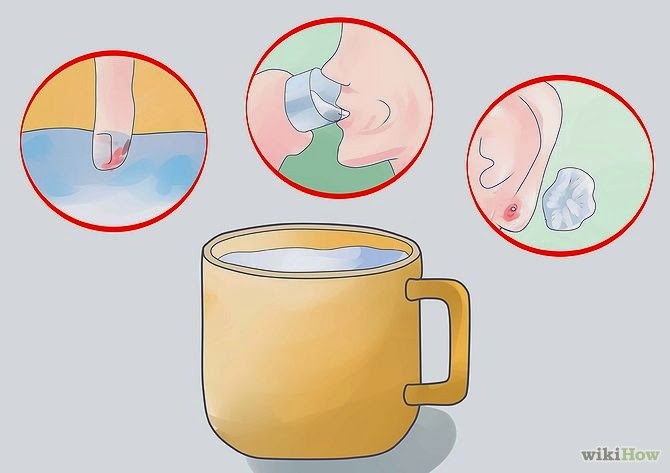Tattoos are often associated with body and design art. Yet it is also popular as a way to achieve permanent cosmetics. Permanent eye liner and lip liner techniques implement the same materials and supplies as the body design tattoos.
Dermatologists are finding an increase of complications such as allergic reactions, serious infections, and reactions to tattoo ink. Some allergic reactions can mimic skin cancer.
So What Is The Body Trying To Accomplish
When It Has An Allergic Reaction?
An allergic reaction is somewhat like a case of mistaken identity within your body's immune system. Normally, your immune system reacts to protect your body against bacteria, viruses or toxic substances.
If you have nickel allergy, your body reacts to nickel and possibly to other metals, such as cobalt and palladium. In other words, it's mistakenly identified nickel as something that could harm you.
Once your body has developed a reaction to a particular agent (allergen) — in this case, nickel — your immune system will always be sensitive to it. That means anytime you come into contact with nickel, your immune system will respond and produce an allergic response.
Your immune system's sensitivity to nickel may develop after your first exposure or after repeated or prolonged exposure. The cause of nickel allergy is unknown, but sensitivity to nickel may, in part, be inherited (genetic).
Source: The Mayo Clinic
Tattoo Ink Allergy and Reactions
Tattoo ink allergy and reactions occur for some people & it is something to consider when getting a tattoo. Reactions commonly come from the pigments used in the ink.
There are a variety of heavy metals that are often used as pigments and some people react to those ingredients. For example, red is a color that is more likely to give allergic problems than others.
What is in Tattoo Ink?
There are 2 basic parts that make up Tattoo Ink
- Pigments to give it color (iron oxides, plastics, mercury, cadmium, nickel, zinc, titanium, iron, and many others)
- Carrier to keep the pigment in suspension to carry it into the dermis and to act as an anti-bacterial/anti-viral agent (alcohol, water, methanol, propylene glycol, glycerin and witch hazel)
Causes of Allergy and Reactions from Tattoo Ink
While allergic reactions to tattoo ink my vary, the most common problems are related to the heavy metal pigments. So if you have an allergy to nickel, copper, iron, iron oxide, and so on, you will probably have a reaction to the tattoo.Black is most commonly achieved from carbon. Sensitivity to carbon is rare. Other sources of black tattoo color may be found in black ink and logwood. Neither of these are metal derivatives, however, the black waterproof ink contains phenol solution in which charcoal particles are suspended and may be the source of other reactions.
Red pigments come from mercury. It is estimated that between 1 and 5 percent of the general population are allergic to mercury.
Yellow pigments is often made by using cadmium. And this ingredient may cause eczema type reactions for some people. And some people have allergic reactions when the cadmium is exposed to light.
Cobalt is used for the blue pigments. Some people experience hypersensitivity and reactions to this ingredient.
Chromium is used for green pigments and causes eczema type reactions for some people.
Maganese is used for purple tattoo designs. Some people have experienced tattoo granulomas when they are allergic to this ingredient.
While allergic reactions are hard to predict, please ask your tattoo artist to conduct a test patch prior to getting the entire tattoo.
Be Aware that MRI Exams May Cause
the Metals in a Tattoo to Temporarily Burn or Sting
Types of Reactions from Tattoo Ink
Some skin diseases may flare when insulted by local skin injury. Psoriasis may flare locally at the tattoo site. This is called the Koebner phenomenon.
Tattoo inks are typically derived from metals that may cause a wide array of skin reactions. While these can be significant if you are the person affected, they tend to be unusual and affect a limited percentage of the tattooed population.
Patch testing to confirm skin reactions is typically positive for eczematous tattoo reactions, but usually is negative for granulomatous reactions.
Initial reactions from the tattoo include local swelling, redness, bleeding and scab formation. This is expected and considered an acute inflammatory response. It usually resolves within a few weeks. Certainly infection of the open wound is also a potential problem. However, the following are problems that may be seen later on with tattoos, even years down the road:Source: The Science of Tattoos
- Lichenoid (small bumps or papules of reactive tissue)
- Sarcoidal granulomas (firm balls of reactive tissue beneath the surface of the skin)
- Scaling
- Itching
- Swelling (often due to a photosensitive/phototoxic reaction)
- Ulceration (the formation of a sore)
- Delayed hypersensitivity (a reaction separated by a significant period of time from getting the tattoo, also referred to within the trade as the red reaction)
- Lymphocytoma Cutis (a skin reaction that mimics lymphoma of the skin and has been associated with tattoos in addition to other causes such as insect bites, some drugs and allergy shots).
Source: American Academy of DermatologySkin cancer
Skin cancer can occur within a tattoo, and for that reason Dr. Shinohara explained that tattoo artists need to be careful not to place a tattoo over an existing mole. However, one reaction that can result is a bump that mimics skin cancer, which can ruin the tattoo.
- This type of bump or lesion that can occur within a tattoo looks like a type of skin cancer known as squamous cell carcinoma. Because the bump is so hard to distinguish from this skin cancer, it requires a biopsy and, in some cases, may need to be treated as a skin cancer, with additional surgery.
- Dr. Shinohara noted that this unusual reaction is thought to stem from tattoo ink and can result in potentially unnecessary and expensive skin cancer treatment.
Safety Precautions in Selecting a Tattoo Artist
- Does the artist autoclave multi-use items? (This is the best way to sterilize instruments)
- Anything that is autoclaved for multiple use must be sealed and dated to ensure sterility.
- Does the artist use single-use sterile disposable needles and tubing?
- Does the artist throwaway leftover ointments, tray, razors, pigments, etc. after completing a tattoo? (Single-use items)
- Does the artist wear gloves?
- Are sterile techniques used during the tattoo process?
- Are needles disposed of in properly labeled containers?
- Does the artist wipe down surfaces with a viricidal/germicidal agent in-between clients?
- Has the artist been vaccinated for Hepatitis B?
- Patch testing is recommended if you are concerned about getting reactions. Give the test area enough time to see if a reaction occurs. So this means you will NOT be getting the tattoo on the same day as the patch test.
In other words, are Universal Precautions performed, just as they would (or should be) in a physician's office? From an artistic point of view, have you reviewed the artist's portfolio? Make sure that the tattoos have sharp lines and smooth edges?
Read more here
Important Considerations When You Have
a Nickel or Metal Allergy
There is no cure for nickel allergy. Once you develop a sensitivity to nickel, you will develop a rash (contact dermatitis) whenever you come into contact with the metal. Once a particular site, such as a tattoo, has reacted to nickel, that site will react even more when re-exposed to nickel.Tattoos are permanent...no surprise. But if you have metal allergies, you need to seriously consider all the ways having a tattoo risks your body will continue to react to have metal pigments within the dermis.
My Personal Thoughts After Learning All This...
My eyes are the area where my nickel and iron oxide allergy is evident. But I went for 2 years of puffy red and watering eyes before we found out that I have this allergic reaction. Read about my experiences here.So I continued to wear my eye make up, which contains iron oxides. I after several months, I decided to stop wearing make up and save it exclusively for special events. People often suggested that I skip the make up and just get my eye liner done permanently with a tattoo. I seriously considered this. But I kept saying I just wasn't sure what was in the pigments used for tattooing, and who would know if I'd react to it.
Thank the Lord I didn't get the tattoo eye liner! It would have been a permanent allergen sitting on my lids!
Other resources:
http://www.tattoomachineequipment.com/tattoo-ink-allergy-and-reactions
http://www.mayoclinic.org/diseases-conditions/nickel-allergy/basics/risk-factors/con-20027616
https://www.aad.org/stories-and-news/news-releases/dermatologist-warns-consumers-about-complications-linked-to-newer-tattoo-inks-
















